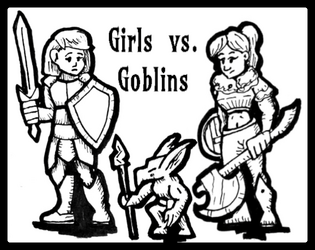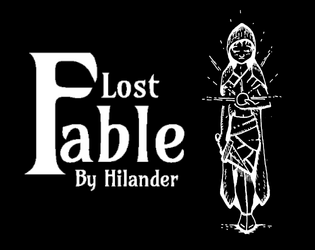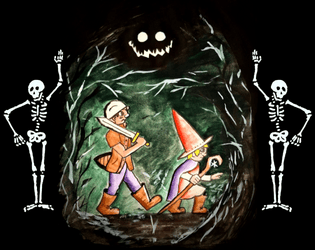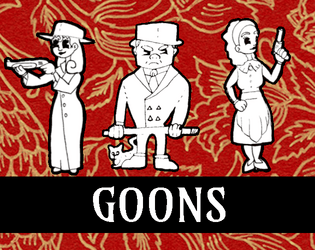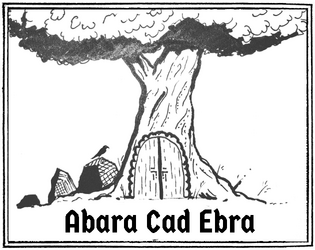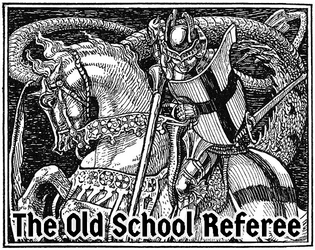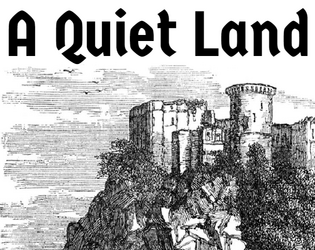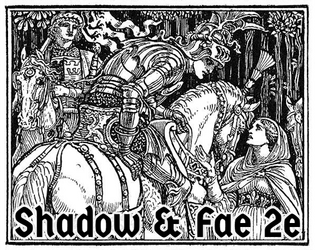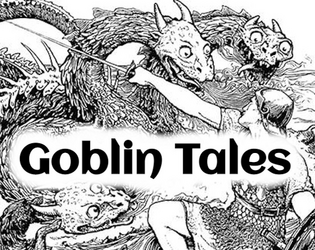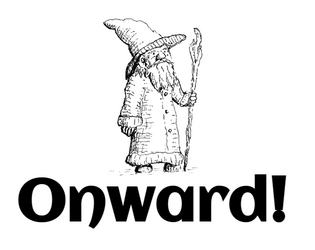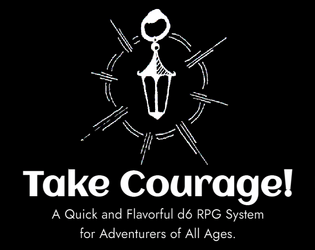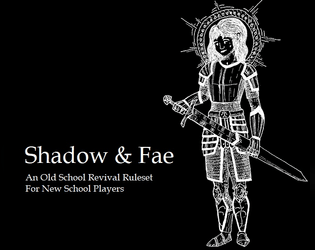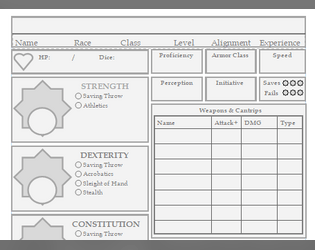I haven't fully taken the time to consider that yet, but I'm open to the idea!
Hilander
Creator of
Recent community posts
The Magic Dice system is pulled straight out of GLoG, so I have some really good news for you! There are about a billion GLoG wizard schools, which should translate almost straight across, but may need some tuning for the system.
Here's a huge (but still incomplete) list: https://attnam.blogspot.com/2018/08/d50-glog-wizard-schools.html?
As long as you remember to scale spells with Dice and Sum, you can make just about anything work.
The Referee section has guidelines for quickly putting monsters together, but no official bestiary is planned. That said, almost any OSR bestiary will work. I personally use the Monster Overhaul, but if you want a free one, the BFRPG bestiary are also excellent.
I think the only major difference is the Unified Save, which is based on HD. That *will* be on the Rereree Screen I'm hoping to make.
Great Question!
I counter: Do you know the exact price of all items on the real world?
An adventurer can likely estimate the rough value of an item, but a merchant would know down to the copper the value of every item in a dragon's hoard, and know what to keep vs. what to leave behind, if it came down to it.
Changing the death system was mainly an issue of simplicity for me. I was really pushing myself to keep the rules as small as possible.
That said, I think you could absolutely swap in the old wounds system for the death roll. Combatants, rather than their d6 death roll benefit, can take +1 wound per chapter of combatant before dying.
Hello! Always exciting to hear that someone's had fun with my games.
Shadow & Fae was my first complete game, which I wrote to bring a group of players familiar with 5e into a simpler but still diverse game. It works with a unified d20 roll-high mechanic for most things, and has classes with similar features and names to the modern giant games, like PF2e and D&D 5e.
I wanted S&F to be a game I could explain quickly, run smoothly, and most of all—create new content for quickly. If one of my players asked, "Can I play a cat?" I wanted to be able to say "Yep! Here's how that could work."
Goblin Tales was inspired by a dice mechanic, originally. The blackjack roll. Instead of having modifiers and scores, players just want to roll as high as they can while staying under their score, with criticals occurring on an exact roll. I was playing around with that idea when someone else suggested classes that really felt as "Fairy Tale" as possible—thieves that stole truth itself, knights that forced opponents to take non-violent oaths, and seers ranging in flavor from the witch of the woods to the saint of the city. It's also the book that really got me thinking about Referee support. You'll notice the magic items from the Old School Referee come straight out of it, because I love the system I made there.
I started S&F2e because I wanted one game that really hit on all cylinders for me. Simple rules, great referee tools, and a lot of flavorful options for players to choose from. I also wanted to keep it more widely compatible, and I found that as much as I loved the Blackjack rule, my players preferred the simplicity of "High Roll Good", and I can't fault them for that.
The biggest addition with S&F2e, that I still kind of play with, is the Hope save mechanic. As a person who really loves stories, I wanted to put out a little bait for players to sometimes try stupid things, like insulting the mayor to his face. Or even to have specific pursuits to act on when they get the chance. My players would often get to town, sell their loot, and look at me with the question of, "Now what?" Well, what does your character want to do? And I'd get silence. Hope and Passions felt like a good way of pre-emptively asking the players "What drives your character?" I've seen it result in some great situations—insulted mayors, street brawls, goo-drinking, theft and chases, etc.—that I don't think would have happened if the players were thinking strictly rationally and strategically.
Besides the Hope mechanic, the other major change was to classes. I wanted to bring in "too-many" according to some people, because I really wanted players to be able to find something that fit well. You'll find Fighter/Thief/Cleric/Mage, but you'll also find a lot of more unique ideas, like Alchemists, Enchanters, and Savants. There are also variations on the "Core-Four" that pull out specific flavors, like Duelists, Druids, Rangers, and Sorcerers. Add in the fact that you can mix-and-match, and I've seen some really interesting character play-styles develop, like a Duelist/Alchemist inspired by the Witcher games, and an Outlander/Enchanter who prepared her own magical weapons and armor depending on what she was hunting.
That's quite a long answer, but you got me thinking!
Thanks again for playing, it really brings me joy that people are enjoying something I've made.
-Hilander
I haven't checked out Knave 2e yet, but I remember enjoying the first edition.
I absolutely love some good tables, but I often felt like they were supporting an unseen architecture that Referees are just supposed to innately understand.
Old School Ref. is my attempt at making (at least one form of) that architecture tangible. Glad you're finding it helpful!
Starting reputation would depend on how power is gained, but I suppose 8 would be normal. It goes up when the ruler does things the population really likes, there are a few examples listed. The Retainers are low-level characters that come with the domain, and can either be sent on NPC missions, or played by players in low-level games.
Does that clear it up?
Great question!
For a single domain run by multiple players, I'd split the stipend, decide jointly on the projects, and decide which player the drama is about each turn by rolling.
That said, you could also give each player a "specialization" within the domain, and the ability to pursue individual projects related to their specialization each turn. For example, one player could be a spy-master, another the architect, another a court wizard, and another the military strategist. This solution has benefits and drawbacks: the main drawback is that each player isn't making as much gold, but the benefit is that they can individually pursue a lot more projects.
And of course, the last option is to just give everyone their own village and make them all Lords and Ladies in service to the king. For added intrigue, have each player inform you of their seasonal actions via a private message or post-it note. They may also send one additional secret note to another player each turn, and may make a public announcement about their intentions. Of course, with the addition of some NPC nobility plotting their own schemes, you'll soon have a system that will kill friendships as surely, though far more subtly, than Monopoly.
Let me know if you have any other questions!
No worries about the wall of text! I really enjoy writing and thinking about these games, so I'm glad mine is worthy of "The Wall" :)
1: Huh... Excellent question. I would let the player choose for now, but I'll look into clarifying that.
2: Players have a max of 4 Chapters from Tales. After that, they only gain new features from adventuring , so the max combatant bonus is +4 (though they still gain max Hope and HP from levels). If someone wants more bonus to hit/damage, they'll need a magic sword or the blessing of an archpriest, or something similar, whatever's available in the world.
3: While sorcerer magic *is* more dangerous, it is also unlimited. Wizards start with 1 guaranteed spell per day, but sorcerers never run out. This is why for a sorcerer, the spells are so much more dangerous. The question isn't when they'll run out of magic, but what chaos they'll unleash as they tap into it.
I hope that all makes sense, and again, thanks for the feedback!
Thanks! Most OSR monsters should basically work without conversion.
That said, Monster Stats basically look like:
- HD (Hit Dice), roll d8 (or 4.5) HP per HD. "Meatier" monsters take 8 HP / HD, weaker monsters take 2 HP / HD.
- Armor: 10-18, based on concept.
- Attacks: Depends on concept. Usually +HD to hit & DMG, max 10.
- Morale: 2-12 (Typically 8), roll 2d6 to test when seriously wounded or ally killed. If the roll exceeds Morale, the monster attempts to flee or bargain.
- Special: I like to give every monster a unique action it "just gets". While most monsters can try anything within reason as an action, Specials work without a test, or force a PC to make a save instead of an opposed roll. For example, any creature can attempt to grapple a PC, but a "Grasping Vine" can use one action to force a PC within 30' to save or become grappled, and can then use its other action to pull that PC towards it. In short, have fun with these, but remember to make it easier for the monster than it would be for any other creature attempting the same thing.
I am hoping to release a Referee's handbook soon—which would include some unique monsters—but refining it has proven to be really tricky!


